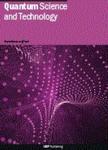版权所有:内蒙古大学图书馆 技术提供:维普资讯• 智图
内蒙古自治区呼和浩特市赛罕区大学西街235号 邮编: 010021

作者机构:Univ Bristol QETLabs HH Wills Phys Lab Merchant Venturers BldgWoodland Rd Bristol BS8 1UB Avon England Univ Bristol Dept Elect & Elect Engn Merchant Venturers BldgWoodland Rd Bristol BS8 1UB Avon England
出 版 物:《QUANTUM SCIENCE AND TECHNOLOGY》 (Quan. Sci. Tech.)
年 卷 期:2019年第4卷第1期
核心收录:
基 金:EPSRC [EP/L015730/1, EP/L024020/1] Leverhulme Trust, through Leverhulme Early Career Fellowship [ECF-2018-276] EPSRC [EP/L024020/1, EP/K033085/1] Funding Source: UKRI
主 题:entanglement graph states postselection photon sources photonic experiment design linear optical quantum computing numerical methods
摘 要:Coherent control of large entangled graph states enables a wide variety of quantum information processing tasks, including error-corrected quantum computation. The linear optical approach offers excellent control and coherence, but today most photon sources and entangling gates-required for the construction of large graph states-are probabilistic and rely on postselection. In this work, we provide proofs and heuristics to aid experimental design using postselection. We introduce a versatile design rule for postselectable experiments: drawn as a graph, with qubit as vertices and gates and photon-pair sources as edges, an experiment may only contain cycles with an odd number of sources. We analyse experiments that use photons from postselected photon-pair sources, and lower bound the number of accessible classes of graph state entanglement in the non-degenerate case-graph state entanglement classes that contain a tree are are always accessible. The proportion of graph states accessible by postselection shrinks rapidly, however. We list accessible classes for various resource states up to 9 qubits. Finally, we apply these methods to near-term multi-photon experiments.